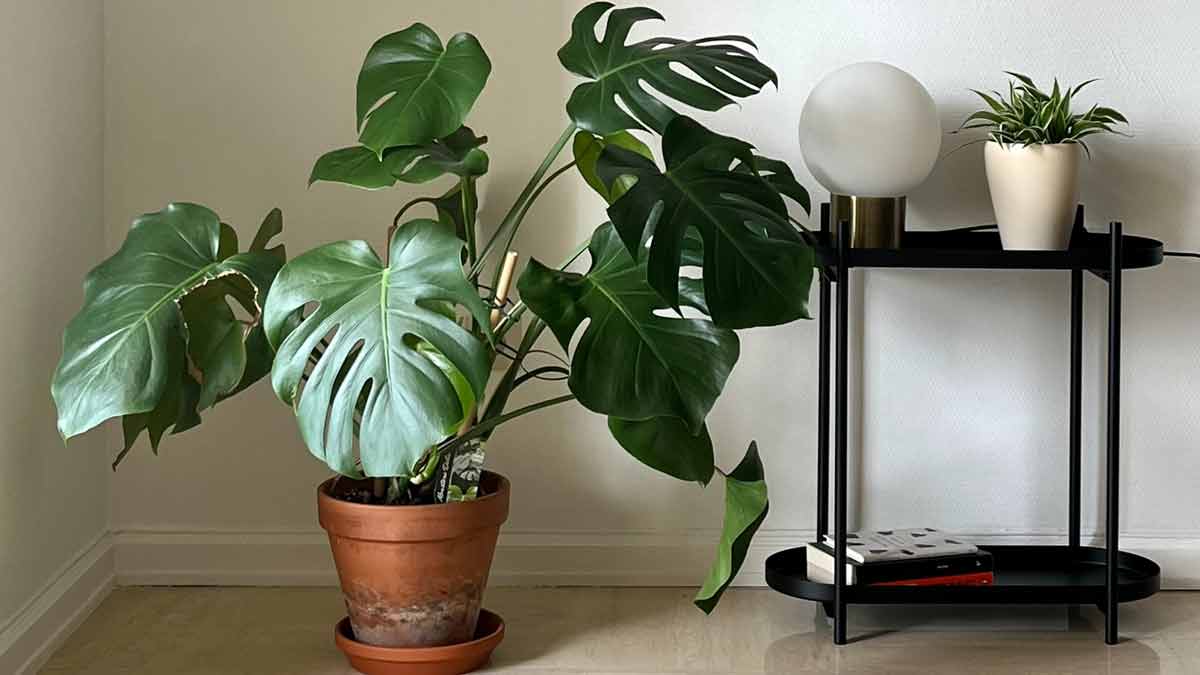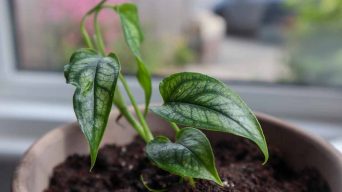To prevent Monstera plants from growing sideways, stake them using a support, rotate them regularly for even sunlight exposure, and check if they are root-bound. This helps to ensure upright growth and prevents slow leaf growth and long aerial roots that can cause the plant to lean to one side.
With their stunning tropical foliage and distinctive split leaves, Monstera plants are popular among plant enthusiasts.
However, these beautiful houseplants can grow sideways, which may leave you wondering how to encourage upright growth for a healthier and more visually pleasing display.
In this article, we will delve into the reasons behind Monstera’s unique growth habits and provide valuable tips on promoting an upright form for your beloved green companion.
So grab your gardening gloves and begin guiding your Monstera toward vertical success!
Understanding Monstera Growth Habits
Monstera plants tend to grow sideways due to their natural climbing habit, which can result in negative effects such as stunted growth and uneven leaf development.
Why Monstera Plants Grow Sideways
When discussing the growth pattern of Monstera plants, it’s important to understand that their natural tendency is to grow sideways due to gravitational influence.
Particularly in their early stages of development, these plants lack the support necessary for vertical growth and may sprawl outwards rather than upwards.
By learning about this behavior and implementing proper care techniques, you can encourage your Monstera plant to develop a stronger structure as it matures.
In the wild, Monsteras are adept climbers that attach themselves to trees with their aerial roots as they ascend towards sunlight in dense rainforest environments.
This upward movement allows them to access more light while receiving nutrients from tree bark and surrounding vegetation.
However, when grown indoors without proper support or guidance, these climbing plants frequently default to growing horizontally instead of vertically.
As a result, owners of indoor Monstera plants should focus on meeting their natural preference for upright growth by providing adequate support systems and fostering healthy habits.
It’s also crucial for Monstera owners to be mindful of potential issues caused by uneven lighting exposure within an indoor setting.
When exposed predominantly from one direction only – directly or indirectly – Monsteras will lean toward the light source in search of nourishment, which may result in lopsided or misshapen growth patterns over time.
To prevent this undesirable leaning effect, it’s recommended that you rotate your plant periodically. Hence, each side receives equal exposure and maintains balanced development throughout its lifespan.
Negative Effects Of Sideways Growth
Sideway growth in monstera plants can lead to a lack of stability, making them prone to falling over or becoming damaged.
As the plant grows heavier with larger leaves and aerial roots, inadequate support may result in broken stems or uprooting, hindering your beloved Monstera’s overall health and development.
Another downside to sideways growth is aesthetics; an unruly and sprawling monstera can take up more space than desired and look less appealing as an indoor decoration.
The plant’s natural beauty lies in its striking foliage patterns, which become obscured when it grows haphazardly.
By promoting upright growth habits, you’ll maintain your plant’s structural integrity and visual appeal within your living space.
Importance Of Upright Growth
Promoting upright growth in Monstera plants is essential as it helps create a beautiful and healthy plant.
When the plant grows sideways, its leaves become crowded and lose their natural shape.
The plant’s overall appearance diminishes as well, making it look less appealing.
Training your Monstera to climb and grow upright will help it develop into a fuller and more vibrant plant with fewer disease problems.
Upright growth also has practical benefits for indoor gardening enthusiasts.
An upward-growing Monstera takes up less space than one that grows sideways or trails down furniture or walls.
And, if you have limited room for plants inside your home or apartment, having an upright-growing Monstera can make all the difference in maximizing space while still enjoying the beauty of this tropical houseplant.
Tips For Promoting Upright Monstera Growth
To promote upright growth in your Monstera plant, consider choosing a pot that is appropriately sized for the root ball, providing proper support using moss poles or other structures, using stretch tie tape to encourage aerial roots to attach and grow upward, pruning to maintain the desired shape and size of the plant, and ensuring adequate lighting and positioning.
1. Providing Proper Support
Providing proper support is one of the most important steps in promoting upright growth for your Monstera plant.
Here are some effective ways to support your plant:
- Moss Pole: A moss pole is popular for supporting Monstera plants as it mimics their natural climbing behavior. It provides stability and encourages the plant to grow upward toward the light. Attach the pole to the pot and add sphagnum moss or coco coir around it to hold it in place.
- Trellis: Another good option is using a trellis, which can be propped up against a wall or hung from the ceiling. This will support your Monstera’s vines to climb up and grow vertically.
- Garden Stakes: Stakes can work well as a supportive structure for smaller Monstera plants. Insert them into the soil at an angle and tie the plant’s stems loosely with stretchy tape or twine.
- Bamboo Canes: Bamboo canes are also great for supporting taller Monstera varieties that require sturdier structures. Place them on either side of the pot and tie up trailing vines using string or twist ties.
Remember, whichever method you choose, make sure it’s securely anchored, so your Monstera doesn’t topple over as it grows taller.
2. Using Stretch Tie Tape To Encourage Aerial Roots
One way to encourage upright growth in Monstera plants is to use stretch tie tape to promote aerial root development.
The tape can be gently wrapped around the plant’s thickest and most mature stems, eventually allowing them to attach themselves to a pole or support system.
As the plant grows, the tape will expand and stretch accordingly.
Training your Monstera plant with stretch tie tape promotes upright growth and helps prevent it from growing sideways and taking up too much space.
This method is particularly useful for larger plants that require more support.
Along with using tie tape, you can provide your Monstera plant with a moss pole or trellis as additional support while encouraging its natural tendency for climbing and vining.
3. Pruning To Maintain Shape
Pruning is an essential part of maintaining the shape of your Monstera plant.
Here are some tips on how to prune your plant effectively:
- Use clean and sharp pruning shears to prevent damage to the stem and leaves.
- Look for yellow or brown leaves, stems starting to rot, or damaged plant parts. These should be removed as they can hinder the growth and appearance of the plant.
- Cut back any leggy pieces growing out of proportion with the rest of the plant. This can encourage fuller growth and make the Monstera grow bushier.
- Cut just above a node (where a leaf joins a stem), as this is where new growth will emerge.
- To encourage horizontal growth, prune vertical stems at their tips by cutting just above a node on a horizontal branch.
- Consider cutting back some of the longer stems or foliage to create a more compact Monstera.
Remember, it’s important not to over-prune your Monstera, as it may cause stress and limit its growth potential.
Prune only when necessary, and remember that Monsteras tend to grow quickly during their growing season, so be prepared for regular maintenance if needed.
4. Ensuring Appropriate Lighting And Positioning
Ensuring appropriate lighting and positioning is a key factor in promoting upright Monstera growth.
Here are some tips to help with this:
- Provide bright, indirect sunlight for at least six hours a day. Avoid intense direct light, which can scorch the leaves.
- Place your Monstera in a spot with plenty of natural light, such as near a window or under a skylight.
- If you have limited natural light, consider using grow lights to supplement it.
- Rotate your Monstera periodically so that all plant parts receive equal amounts of light.
- Keep your Monstera away from drafts or air conditioning vents, which can cause stress and damage to the plant.
By following these tips, you can ensure that your Monstera gets the right amount of light and grows upright and healthy.
Common Mistakes To Avoid
Avoid overwatering or underwatering your Monstera plant.
Make sure the soil is moist but not soggy, and that excess water drains out of the pot.
Insufficient support or training can lead to sideways growth, so use sturdy stakes or trellises when necessary.
Incorrect lighting or positioning can stunt growth and cause leaves to turn yellow and fall off, so be mindful of where you place your Monstera in your home.
Finally, using the wrong pot size or soil type can inhibit root growth and lead to poor overall health for your plant.
1. Overwatering Or Underwatering
Overwatering or underwatering can harm the growth and health of your monstera plants.
Here are some important facts to keep in mind:
- Overwatering can cause monstera plants to have yellowing leaves, wilting, dark spots on leaves, and a foul odor emanating from the soil. It is important to allow the top inch of soil to dry out before watering again.
- Underwatering can cause monstera plants to have dry soil, drooping or sagging stems, curling or discolored leaves, and a lack of new leaves with fenestrations. It is crucial to ensure that your plant receives enough water by regularly checking the soil’s moisture level.
- Inconsistent and insufficient watering can cause the soil to dry out too much, resulting in brown tips on the leaves of monstera plants. You should water your Monstera plant thoroughly once a week during the growing season and adjust accordingly during winter.
- Over time, severe cases of root rot caused by overwatering can cause monstera plants to stop growing and the leaves to slowly die off. Avoid this by ensuring proper drainage in your pot and not leaving excess water sitting in saucers for long periods.
Remember that watering is key when caring for your monstera plant. Be sure to monitor its needs regularly and adjust accordingly.
2. Insufficient Support Or Training
One of plant enthusiasts’ most common mistakes in preventing Monstera from growing sideways is insufficient support or training. Here are some tips to avoid this:
- Use a moss pole, trellis, stake, or bamboo stick to support the Monstera plant vertically.
- As it grows, tie the stem to the stake using a plant tie or stretch tie tape to keep it upright.
- Make sure that the support is sturdy enough to handle the weight of the Monstera as it matures and produces larger leaves.
- Train the aerial roots to grow around the moss pole or other support structure to provide additional stability and nutrients to the plant.
By providing sufficient support and training, your Monstera plant will be able to grow upright and develop into a beautiful specimen with large, healthy leaves.
Remember that every Monstera has its own personality and growth habit, so be patient as you work on getting yours to grow in the way you want it to.
3. Incorrect Lighting Or Positioning
Incorrect lighting or positioning is one of the most common mistakes that can cause Monstera to grow sideways.
To prevent this, consider the following tips:
- Provide filtered, indirect sunlight: Too much direct sunlight can burn the leaves and cause them to wilt. On the other hand, insufficient light can prevent Monstera from growing upright.
- Rotate the plant regularly: If a Monstera is placed near a window, it may lean towards the light source and become unbalanced. Rotating it every few weeks can ensure even growth.
- Keep away from drafty areas: Avoid placing Monstera near air conditioning or heating vents, as this can cause stress to the plant and affect its growth.
- Choose an appropriate location: Monstera grows best in an area with consistent natural light and stable temperature between 65-85°F.
- Avoid overcrowding: Crowding houseplants together in one spot can block their access to sunlight and reduce healthy growth.
Considering these measures, you’ll help ensure that your Monstera thrives in an optimal environment for upright growth.
4. Using The Wrong Pot Or Soil
Using the wrong pot or soil can hinder Monstera’s growth and impact its ability to grow upright.
Here are some common mistakes to avoid:
- Choosing a pot that is too small: Monstera requires room for root development, and selecting a pot that is too small will limit its growth potential.
- Using heavy soil: Heavy soils, such as garden or clay-based soils, can cause waterlogging, leading to root rot and stunted growth. A well-draining soil mix is crucial for optimal growth.
- Choosing the wrong type of soil: Monstera prefers a well-aerated soil mix that allows sufficient air circulation around the roots. Peat moss or soil mixes with high organic matter content can result in poor drainage and compaction.
- Lack of nutrients: If Monstera is not thriving, it may be due to a lack of essential nutrients such as nitrogen, phosphorus, or potassium. Fertilizing with a balanced fertilizer every 4-6 weeks during the growing season can help provide the necessary nutrients.
- Overfertilization: Overfertilization can cause nutrient burn, leading to leaf discoloration and scorching. It is recommended to follow instructions on the fertilizer package carefully.
Using the correct size pot with a well-draining soil mix and appropriately fertilizing, your Monstera will thrive and grow upright as desired!
5. Poor Pruning Practices
When it comes to pruning your monstera plant, there are several mistakes that you should avoid.
Poor pruning practices can lead to stunted growth, unbalanced aesthetics, and even damage to the plant’s health.
Here are some common pruning mistakes to watch out for:
- Cutting too much: While trimming all of the excess foliage at once may be tempting, removing too many leaves can cause your monstera plant to suffer. Cut at most 1/3 of the leaves at a time.
- Trimming at the wrong point: Prune your monstera plant at the node where new leaf growth originates. Incorrect trimming can lead to damaged stems or unhealthy leaves.
- Not disinfecting tools: Dirty pruning shears and scissors can spread disease from one plant to another. Make sure to clean your tools with rubbing alcohol or bleach in between uses.
- Failing to consider the growing season: The growing season for a monstera plant is typical during the spring and summer. Avoid major pruning outside of this period, as it could interfere with healthy growth and cause stress on your plant.
- Removing aerial roots: Aerial roots help support and anchor your monstera plant as it grows taller. If you cut off these roots, you risk destabilizing the plant’s foundation and causing it to lean or fall over.
By avoiding these poor pruning practices and taking care when trimming your monstera plants, you can help promote healthy upright growth and maintain an attractive appearance for years to come!
Final Thoughts
Keeping your Monstera plant upright is essential for its health and overall appearance.
Understanding the growth habits of this beautiful tropical plant will help you identify the best ways to promote upright growth.
You can keep your Monstera thriving in an upright position by providing proper support, using stretch tie tape to encourage aerial roots, pruning to maintain shape, ensuring appropriate lighting and positioning, and avoiding common mistakes.
With these tips and tricks on preventing your Monstera from growing sideways, your home jungle will flourish with beautiful foliage in no time!







